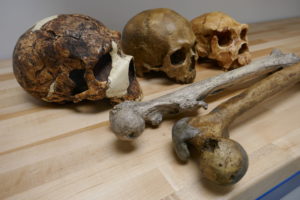When it comes to human prehistoric ancestors, where they lived had a direct impact on their body mass, but less so on their brain size.
This is according to a new research by an interdisciplinary team from Canada and Europe, which found that early humans who lived in colder climates tended to have bigger body sizes than their counterparts who lived in warmer environments.
Jay Stock, professor in the Department of Anthropology at Western University, and Manuel Will at the University of Tübingen, Germany, gathered measurements of body and brain size for over 300 fossils from the genus Homo found across the globe. They teamed up with ecologists and climatologists from the University of Cambridge to combine this data with a reconstruction of the world’s regional climates over the last million years, and pinpoint the specific climate experienced by each fossil when it was a living human.
The combined research showed that while changes in temperature closely correlate to changes in body size, there is a weaker connection between environment and brain size. Colder, harsher climates drove the evolution of larger body sizes, while warmer climates led to smaller bodies. Larger bodies are thought to act as a buffer against colder temperatures; less heat is lost from a body when its mass is large relative to its surface area.
The researchers also looked at the effect of environmental factors on brain size in the genus Homo, but correlations were generally weak. Brain size tended to be larger when Homo was living in habitats with less vegetation, like open steppes and grasslands, but also in ecologically more stable areas. In combination with archaeological data, the results suggest that people living in these habitats hunted large animals as food – a complex task that might have driven the evolution of larger brains.
“We found that different factors determine brain size and body size – they’re not under the same evolutionary pressures. The environment has a much greater influence on our body size than our brain size,” said Will at the University of Tubingen, Germany, first author of the study.
The research was made possible through new statistical approaches applied to early human physiology, and to climate models.
Traditional approaches of estimating body mass relied primarily on measurements of the femoral head, the highest part of the thigh bone. Well-preserved femoral heads were not present in many fossils.
“Previous studies have estimated brain and body size from a small number of fossils that are relatively complete,” said Stock. “We found ways to extrapolate data from more, incomplete fossils.”
Stock and Will took hundreds of measurements of different human bones to determine how predictive they were of body mass. With these measurements, they were able to expand the number and types of bones that could be used to get reliable mass data. Applying the new approach increases the number of fossil samples of early humans available to researchers to include 10 times the data of most previous studies.

Casts of fossils illustrating brain and body size variation within the past one million years, including crania of Neandertals (Amud), Homo sapiens (Cro-Magnon) and middle Pleistocene Homo (Atapuerca 5), as well as femora of Mid-Pleistocene Homo (Trinil) and a Neandertal (La Ferassie) Photo by Jay Stock
This approach was paired with research from the University of Cambridge, conducted by ecologists Andrea Manica and Mario Krapp, which extended climate models back one million years. With these models, the group could test the relationship between body size and climate over a much longer time scale.
“We brought together these different approaches to test hypotheses that hadn’t been directly tested before,” said Stock. “The first assumption of most evolutionary biologists is that environments drive most changes in species. To show it’s only a small effect and to demonstrate that statistically, is really important.”
The research, Stock noted, showed the impact of climate on earlier species within the genus Homo, including Neanderthals. The impacts and research do not apply to Homo sapiens, which emerged around 300,000 years ago in Africa.
With the new method tested, Stock hopes they can extend the analysis beyond the million years looked at in the paper.
“Many of the most interesting changes in the brains and bodies of our ancestors happened between 4 million and one million years ago,” said Stock. “In future, we hope to look at the earlier evolution of traits such as brain size or bipedalism to determine whether there were specific environmental correlates.”
The results are outlined in the study, “Different environmental variables predict body and brain size evolution in Homo,” published in the journal Nature Communications.


